Corona Virus Respiratory Infection: Pathogen Characterization Report
VerifiedAdded on 2021/04/21
|8
|3255
|197
Report
AI Summary
This report examines the Corona Virus Respiratory Infection, a significant global health concern. It investigates the virus's characteristics, focusing on the need for a vaccine, given the high mortality rates associated with respiratory diseases. The report reviews existing literature on vaccine development, including the use of viral envelope antigens. It outlines a study plan that includes identifying the virus, raising specific antibodies, and determining the structural components for vaccine preparation. The methodology section details various molecular biology and immunological techniques for virus detection and analysis, such as polyclonal and monoclonal antibody production, immunoprecipitation, solid-phase antibody assays, flow cytometry, and Luminux analysis. The report emphasizes the importance of these techniques in understanding the virus and developing effective vaccines to combat the spread of the infection.
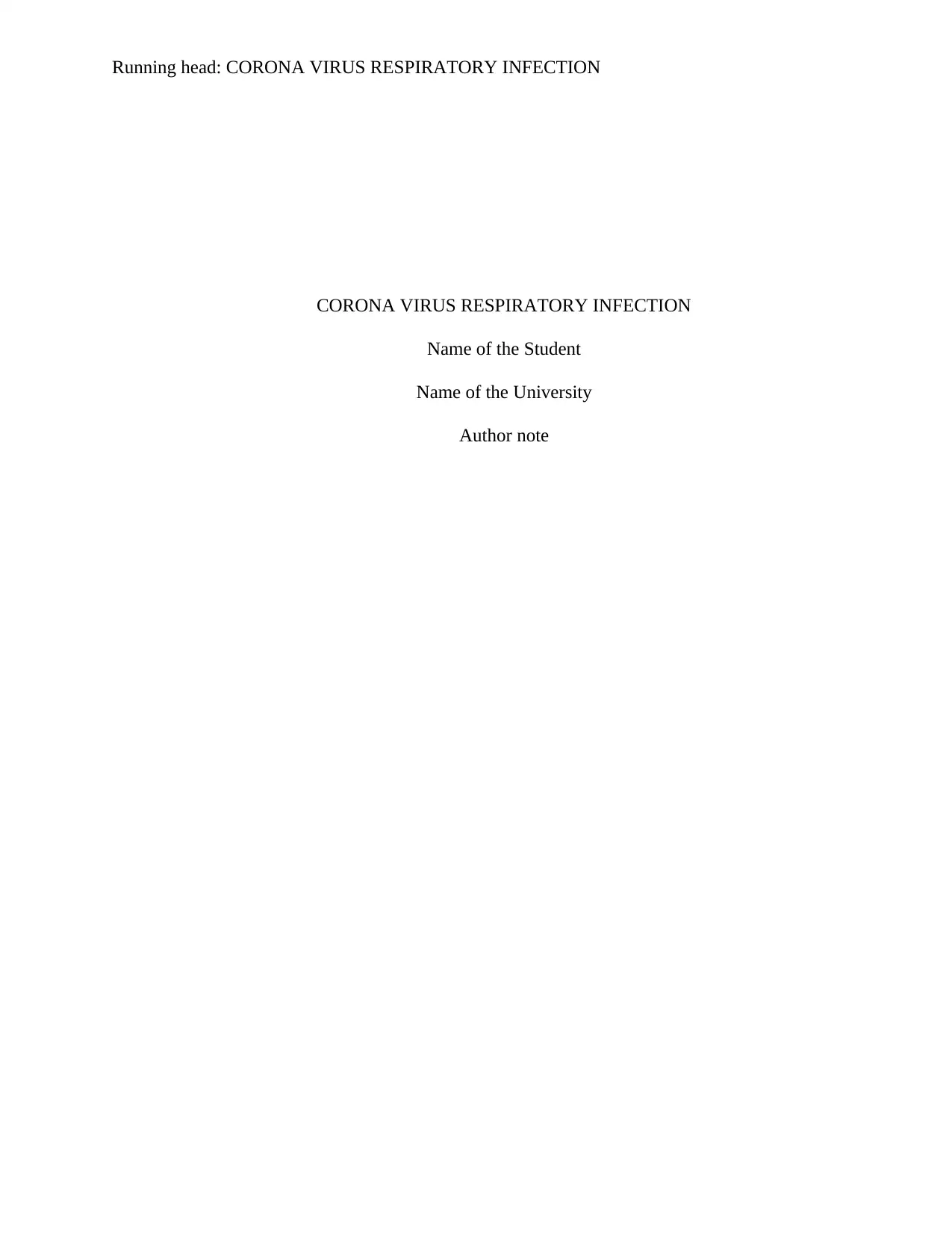
Running head: CORONA VIRUS RESPIRATORY INFECTION
CORONA VIRUS RESPIRATORY INFECTION
Name of the Student
Name of the University
Author note
CORONA VIRUS RESPIRATORY INFECTION
Name of the Student
Name of the University
Author note
Paraphrase This Document
Need a fresh take? Get an instant paraphrase of this document with our AI Paraphraser
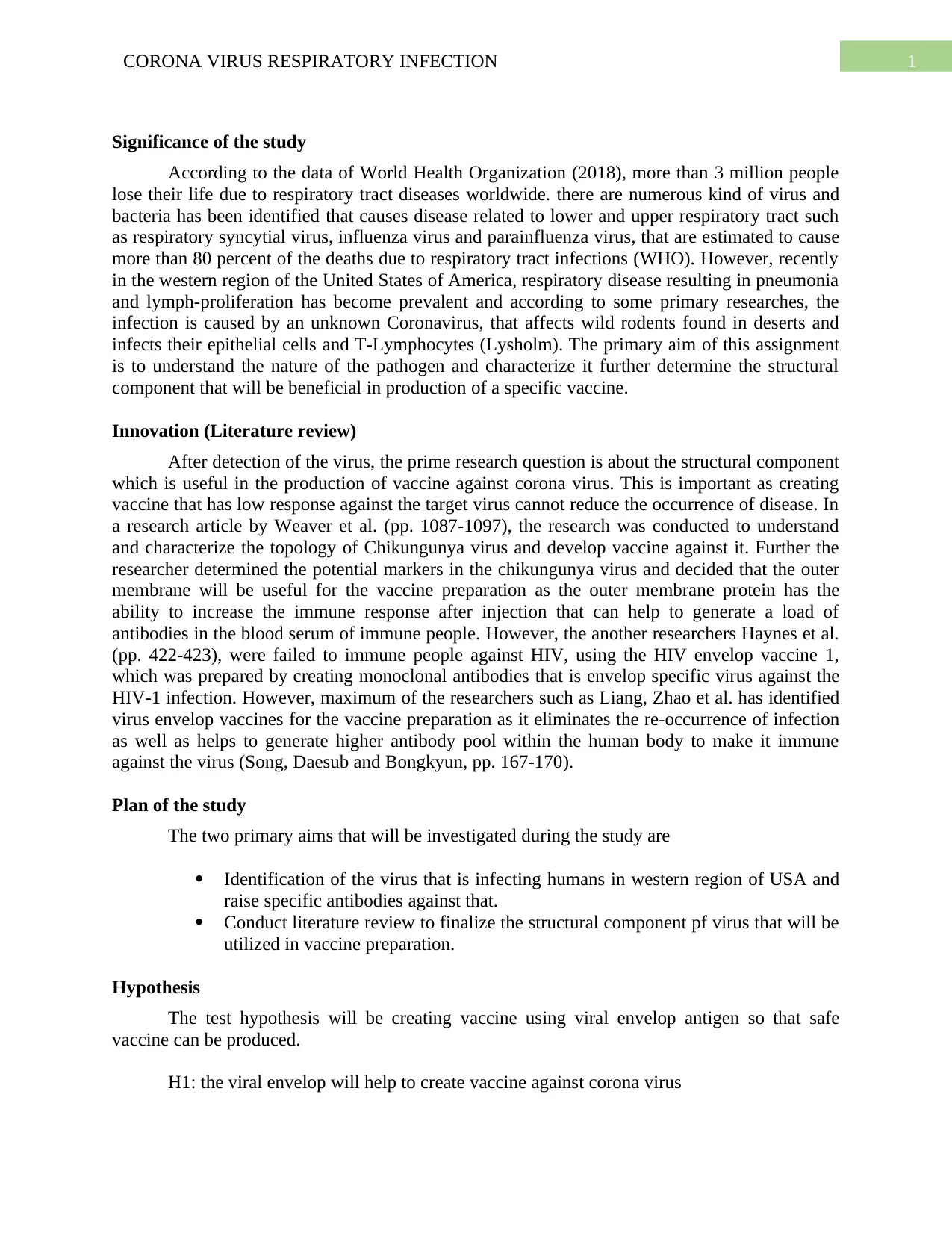
1CORONA VIRUS RESPIRATORY INFECTION
Significance of the study
According to the data of World Health Organization (2018), more than 3 million people
lose their life due to respiratory tract diseases worldwide. there are numerous kind of virus and
bacteria has been identified that causes disease related to lower and upper respiratory tract such
as respiratory syncytial virus, influenza virus and parainfluenza virus, that are estimated to cause
more than 80 percent of the deaths due to respiratory tract infections (WHO). However, recently
in the western region of the United States of America, respiratory disease resulting in pneumonia
and lymph-proliferation has become prevalent and according to some primary researches, the
infection is caused by an unknown Coronavirus, that affects wild rodents found in deserts and
infects their epithelial cells and T-Lymphocytes (Lysholm). The primary aim of this assignment
is to understand the nature of the pathogen and characterize it further determine the structural
component that will be beneficial in production of a specific vaccine.
Innovation (Literature review)
After detection of the virus, the prime research question is about the structural component
which is useful in the production of vaccine against corona virus. This is important as creating
vaccine that has low response against the target virus cannot reduce the occurrence of disease. In
a research article by Weaver et al. (pp. 1087-1097), the research was conducted to understand
and characterize the topology of Chikungunya virus and develop vaccine against it. Further the
researcher determined the potential markers in the chikungunya virus and decided that the outer
membrane will be useful for the vaccine preparation as the outer membrane protein has the
ability to increase the immune response after injection that can help to generate a load of
antibodies in the blood serum of immune people. However, the another researchers Haynes et al.
(pp. 422-423), were failed to immune people against HIV, using the HIV envelop vaccine 1,
which was prepared by creating monoclonal antibodies that is envelop specific virus against the
HIV-1 infection. However, maximum of the researchers such as Liang, Zhao et al. has identified
virus envelop vaccines for the vaccine preparation as it eliminates the re-occurrence of infection
as well as helps to generate higher antibody pool within the human body to make it immune
against the virus (Song, Daesub and Bongkyun, pp. 167-170).
Plan of the study
The two primary aims that will be investigated during the study are
Identification of the virus that is infecting humans in western region of USA and
raise specific antibodies against that.
Conduct literature review to finalize the structural component pf virus that will be
utilized in vaccine preparation.
Hypothesis
The test hypothesis will be creating vaccine using viral envelop antigen so that safe
vaccine can be produced.
H1: the viral envelop will help to create vaccine against corona virus
Significance of the study
According to the data of World Health Organization (2018), more than 3 million people
lose their life due to respiratory tract diseases worldwide. there are numerous kind of virus and
bacteria has been identified that causes disease related to lower and upper respiratory tract such
as respiratory syncytial virus, influenza virus and parainfluenza virus, that are estimated to cause
more than 80 percent of the deaths due to respiratory tract infections (WHO). However, recently
in the western region of the United States of America, respiratory disease resulting in pneumonia
and lymph-proliferation has become prevalent and according to some primary researches, the
infection is caused by an unknown Coronavirus, that affects wild rodents found in deserts and
infects their epithelial cells and T-Lymphocytes (Lysholm). The primary aim of this assignment
is to understand the nature of the pathogen and characterize it further determine the structural
component that will be beneficial in production of a specific vaccine.
Innovation (Literature review)
After detection of the virus, the prime research question is about the structural component
which is useful in the production of vaccine against corona virus. This is important as creating
vaccine that has low response against the target virus cannot reduce the occurrence of disease. In
a research article by Weaver et al. (pp. 1087-1097), the research was conducted to understand
and characterize the topology of Chikungunya virus and develop vaccine against it. Further the
researcher determined the potential markers in the chikungunya virus and decided that the outer
membrane will be useful for the vaccine preparation as the outer membrane protein has the
ability to increase the immune response after injection that can help to generate a load of
antibodies in the blood serum of immune people. However, the another researchers Haynes et al.
(pp. 422-423), were failed to immune people against HIV, using the HIV envelop vaccine 1,
which was prepared by creating monoclonal antibodies that is envelop specific virus against the
HIV-1 infection. However, maximum of the researchers such as Liang, Zhao et al. has identified
virus envelop vaccines for the vaccine preparation as it eliminates the re-occurrence of infection
as well as helps to generate higher antibody pool within the human body to make it immune
against the virus (Song, Daesub and Bongkyun, pp. 167-170).
Plan of the study
The two primary aims that will be investigated during the study are
Identification of the virus that is infecting humans in western region of USA and
raise specific antibodies against that.
Conduct literature review to finalize the structural component pf virus that will be
utilized in vaccine preparation.
Hypothesis
The test hypothesis will be creating vaccine using viral envelop antigen so that safe
vaccine can be produced.
H1: the viral envelop will help to create vaccine against corona virus
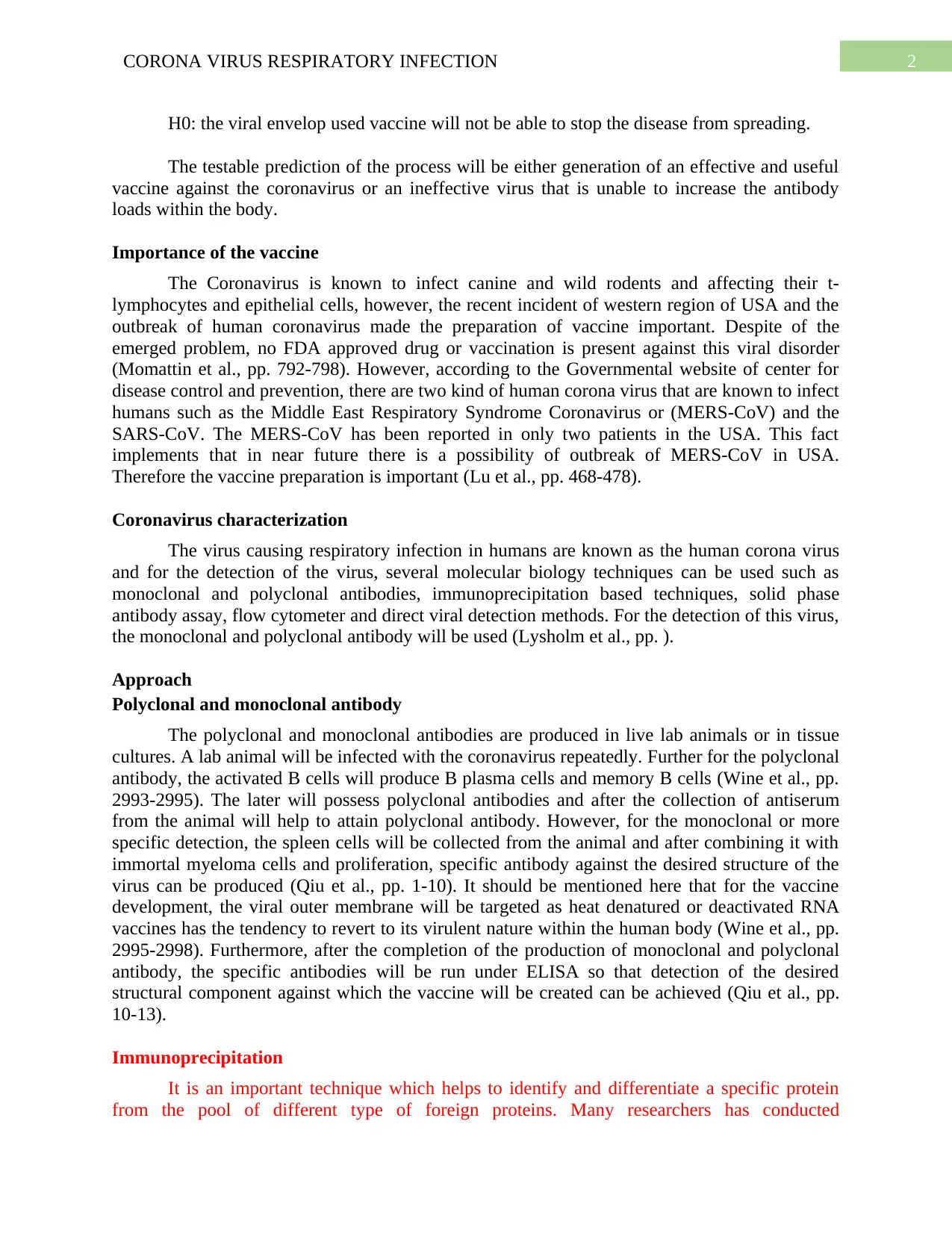
2CORONA VIRUS RESPIRATORY INFECTION
H0: the viral envelop used vaccine will not be able to stop the disease from spreading.
The testable prediction of the process will be either generation of an effective and useful
vaccine against the coronavirus or an ineffective virus that is unable to increase the antibody
loads within the body.
Importance of the vaccine
The Coronavirus is known to infect canine and wild rodents and affecting their t-
lymphocytes and epithelial cells, however, the recent incident of western region of USA and the
outbreak of human coronavirus made the preparation of vaccine important. Despite of the
emerged problem, no FDA approved drug or vaccination is present against this viral disorder
(Momattin et al., pp. 792-798). However, according to the Governmental website of center for
disease control and prevention, there are two kind of human corona virus that are known to infect
humans such as the Middle East Respiratory Syndrome Coronavirus or (MERS-CoV) and the
SARS-CoV. The MERS-CoV has been reported in only two patients in the USA. This fact
implements that in near future there is a possibility of outbreak of MERS-CoV in USA.
Therefore the vaccine preparation is important (Lu et al., pp. 468-478).
Coronavirus characterization
The virus causing respiratory infection in humans are known as the human corona virus
and for the detection of the virus, several molecular biology techniques can be used such as
monoclonal and polyclonal antibodies, immunoprecipitation based techniques, solid phase
antibody assay, flow cytometer and direct viral detection methods. For the detection of this virus,
the monoclonal and polyclonal antibody will be used (Lysholm et al., pp. ).
Approach
Polyclonal and monoclonal antibody
The polyclonal and monoclonal antibodies are produced in live lab animals or in tissue
cultures. A lab animal will be infected with the coronavirus repeatedly. Further for the polyclonal
antibody, the activated B cells will produce B plasma cells and memory B cells (Wine et al., pp.
2993-2995). The later will possess polyclonal antibodies and after the collection of antiserum
from the animal will help to attain polyclonal antibody. However, for the monoclonal or more
specific detection, the spleen cells will be collected from the animal and after combining it with
immortal myeloma cells and proliferation, specific antibody against the desired structure of the
virus can be produced (Qiu et al., pp. 1-10). It should be mentioned here that for the vaccine
development, the viral outer membrane will be targeted as heat denatured or deactivated RNA
vaccines has the tendency to revert to its virulent nature within the human body (Wine et al., pp.
2995-2998). Furthermore, after the completion of the production of monoclonal and polyclonal
antibody, the specific antibodies will be run under ELISA so that detection of the desired
structural component against which the vaccine will be created can be achieved (Qiu et al., pp.
10-13).
Immunoprecipitation
It is an important technique which helps to identify and differentiate a specific protein
from the pool of different type of foreign proteins. Many researchers has conducted
H0: the viral envelop used vaccine will not be able to stop the disease from spreading.
The testable prediction of the process will be either generation of an effective and useful
vaccine against the coronavirus or an ineffective virus that is unable to increase the antibody
loads within the body.
Importance of the vaccine
The Coronavirus is known to infect canine and wild rodents and affecting their t-
lymphocytes and epithelial cells, however, the recent incident of western region of USA and the
outbreak of human coronavirus made the preparation of vaccine important. Despite of the
emerged problem, no FDA approved drug or vaccination is present against this viral disorder
(Momattin et al., pp. 792-798). However, according to the Governmental website of center for
disease control and prevention, there are two kind of human corona virus that are known to infect
humans such as the Middle East Respiratory Syndrome Coronavirus or (MERS-CoV) and the
SARS-CoV. The MERS-CoV has been reported in only two patients in the USA. This fact
implements that in near future there is a possibility of outbreak of MERS-CoV in USA.
Therefore the vaccine preparation is important (Lu et al., pp. 468-478).
Coronavirus characterization
The virus causing respiratory infection in humans are known as the human corona virus
and for the detection of the virus, several molecular biology techniques can be used such as
monoclonal and polyclonal antibodies, immunoprecipitation based techniques, solid phase
antibody assay, flow cytometer and direct viral detection methods. For the detection of this virus,
the monoclonal and polyclonal antibody will be used (Lysholm et al., pp. ).
Approach
Polyclonal and monoclonal antibody
The polyclonal and monoclonal antibodies are produced in live lab animals or in tissue
cultures. A lab animal will be infected with the coronavirus repeatedly. Further for the polyclonal
antibody, the activated B cells will produce B plasma cells and memory B cells (Wine et al., pp.
2993-2995). The later will possess polyclonal antibodies and after the collection of antiserum
from the animal will help to attain polyclonal antibody. However, for the monoclonal or more
specific detection, the spleen cells will be collected from the animal and after combining it with
immortal myeloma cells and proliferation, specific antibody against the desired structure of the
virus can be produced (Qiu et al., pp. 1-10). It should be mentioned here that for the vaccine
development, the viral outer membrane will be targeted as heat denatured or deactivated RNA
vaccines has the tendency to revert to its virulent nature within the human body (Wine et al., pp.
2995-2998). Furthermore, after the completion of the production of monoclonal and polyclonal
antibody, the specific antibodies will be run under ELISA so that detection of the desired
structural component against which the vaccine will be created can be achieved (Qiu et al., pp.
10-13).
Immunoprecipitation
It is an important technique which helps to identify and differentiate a specific protein
from the pool of different type of foreign proteins. Many researchers has conducted
⊘ This is a preview!⊘
Do you want full access?
Subscribe today to unlock all pages.

Trusted by 1+ million students worldwide
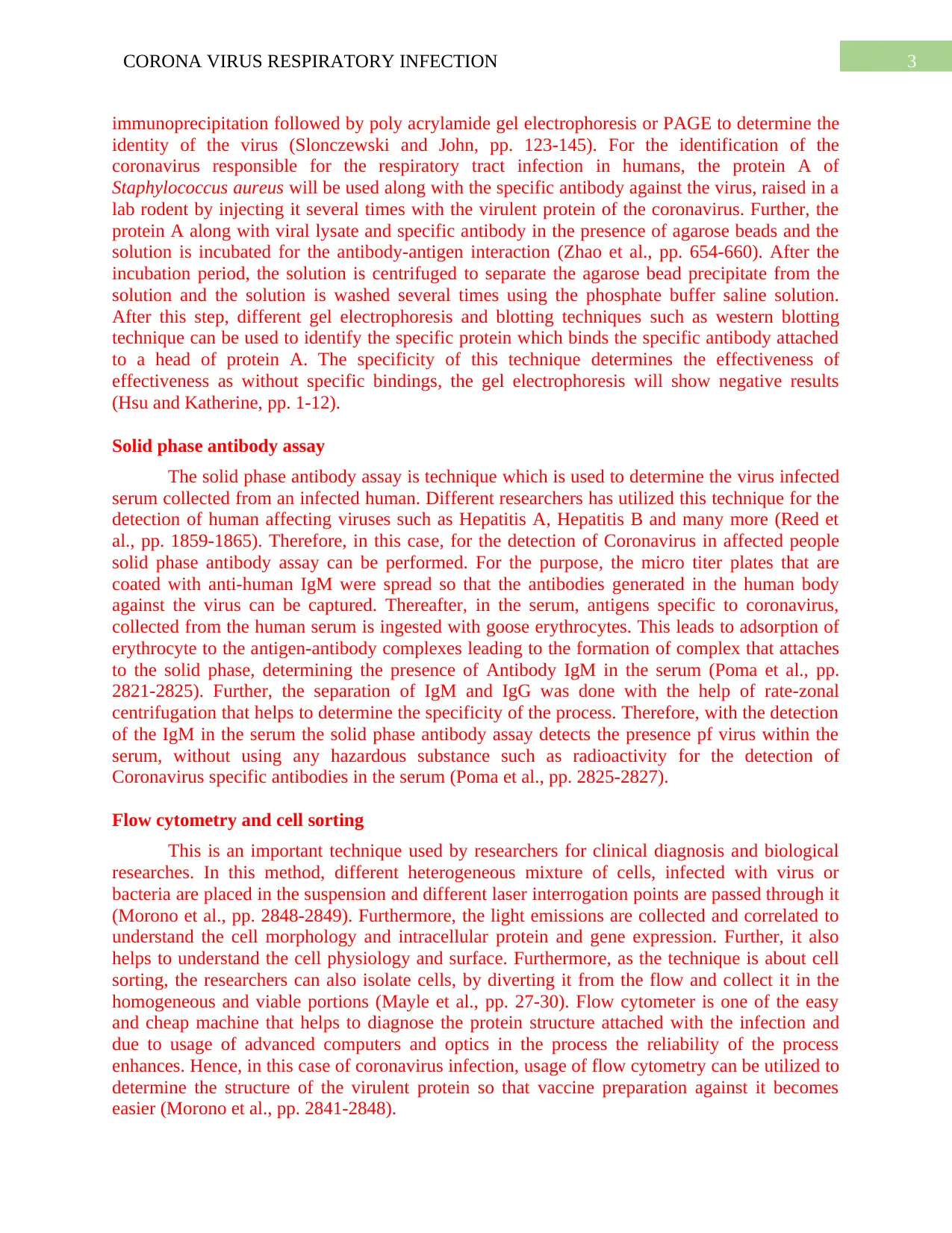
3CORONA VIRUS RESPIRATORY INFECTION
immunoprecipitation followed by poly acrylamide gel electrophoresis or PAGE to determine the
identity of the virus (Slonczewski and John, pp. 123-145). For the identification of the
coronavirus responsible for the respiratory tract infection in humans, the protein A of
Staphylococcus aureus will be used along with the specific antibody against the virus, raised in a
lab rodent by injecting it several times with the virulent protein of the coronavirus. Further, the
protein A along with viral lysate and specific antibody in the presence of agarose beads and the
solution is incubated for the antibody-antigen interaction (Zhao et al., pp. 654-660). After the
incubation period, the solution is centrifuged to separate the agarose bead precipitate from the
solution and the solution is washed several times using the phosphate buffer saline solution.
After this step, different gel electrophoresis and blotting techniques such as western blotting
technique can be used to identify the specific protein which binds the specific antibody attached
to a head of protein A. The specificity of this technique determines the effectiveness of
effectiveness as without specific bindings, the gel electrophoresis will show negative results
(Hsu and Katherine, pp. 1-12).
Solid phase antibody assay
The solid phase antibody assay is technique which is used to determine the virus infected
serum collected from an infected human. Different researchers has utilized this technique for the
detection of human affecting viruses such as Hepatitis A, Hepatitis B and many more (Reed et
al., pp. 1859-1865). Therefore, in this case, for the detection of Coronavirus in affected people
solid phase antibody assay can be performed. For the purpose, the micro titer plates that are
coated with anti-human IgM were spread so that the antibodies generated in the human body
against the virus can be captured. Thereafter, in the serum, antigens specific to coronavirus,
collected from the human serum is ingested with goose erythrocytes. This leads to adsorption of
erythrocyte to the antigen-antibody complexes leading to the formation of complex that attaches
to the solid phase, determining the presence of Antibody IgM in the serum (Poma et al., pp.
2821-2825). Further, the separation of IgM and IgG was done with the help of rate-zonal
centrifugation that helps to determine the specificity of the process. Therefore, with the detection
of the IgM in the serum the solid phase antibody assay detects the presence pf virus within the
serum, without using any hazardous substance such as radioactivity for the detection of
Coronavirus specific antibodies in the serum (Poma et al., pp. 2825-2827).
Flow cytometry and cell sorting
This is an important technique used by researchers for clinical diagnosis and biological
researches. In this method, different heterogeneous mixture of cells, infected with virus or
bacteria are placed in the suspension and different laser interrogation points are passed through it
(Morono et al., pp. 2848-2849). Furthermore, the light emissions are collected and correlated to
understand the cell morphology and intracellular protein and gene expression. Further, it also
helps to understand the cell physiology and surface. Furthermore, as the technique is about cell
sorting, the researchers can also isolate cells, by diverting it from the flow and collect it in the
homogeneous and viable portions (Mayle et al., pp. 27-30). Flow cytometer is one of the easy
and cheap machine that helps to diagnose the protein structure attached with the infection and
due to usage of advanced computers and optics in the process the reliability of the process
enhances. Hence, in this case of coronavirus infection, usage of flow cytometry can be utilized to
determine the structure of the virulent protein so that vaccine preparation against it becomes
easier (Morono et al., pp. 2841-2848).
immunoprecipitation followed by poly acrylamide gel electrophoresis or PAGE to determine the
identity of the virus (Slonczewski and John, pp. 123-145). For the identification of the
coronavirus responsible for the respiratory tract infection in humans, the protein A of
Staphylococcus aureus will be used along with the specific antibody against the virus, raised in a
lab rodent by injecting it several times with the virulent protein of the coronavirus. Further, the
protein A along with viral lysate and specific antibody in the presence of agarose beads and the
solution is incubated for the antibody-antigen interaction (Zhao et al., pp. 654-660). After the
incubation period, the solution is centrifuged to separate the agarose bead precipitate from the
solution and the solution is washed several times using the phosphate buffer saline solution.
After this step, different gel electrophoresis and blotting techniques such as western blotting
technique can be used to identify the specific protein which binds the specific antibody attached
to a head of protein A. The specificity of this technique determines the effectiveness of
effectiveness as without specific bindings, the gel electrophoresis will show negative results
(Hsu and Katherine, pp. 1-12).
Solid phase antibody assay
The solid phase antibody assay is technique which is used to determine the virus infected
serum collected from an infected human. Different researchers has utilized this technique for the
detection of human affecting viruses such as Hepatitis A, Hepatitis B and many more (Reed et
al., pp. 1859-1865). Therefore, in this case, for the detection of Coronavirus in affected people
solid phase antibody assay can be performed. For the purpose, the micro titer plates that are
coated with anti-human IgM were spread so that the antibodies generated in the human body
against the virus can be captured. Thereafter, in the serum, antigens specific to coronavirus,
collected from the human serum is ingested with goose erythrocytes. This leads to adsorption of
erythrocyte to the antigen-antibody complexes leading to the formation of complex that attaches
to the solid phase, determining the presence of Antibody IgM in the serum (Poma et al., pp.
2821-2825). Further, the separation of IgM and IgG was done with the help of rate-zonal
centrifugation that helps to determine the specificity of the process. Therefore, with the detection
of the IgM in the serum the solid phase antibody assay detects the presence pf virus within the
serum, without using any hazardous substance such as radioactivity for the detection of
Coronavirus specific antibodies in the serum (Poma et al., pp. 2825-2827).
Flow cytometry and cell sorting
This is an important technique used by researchers for clinical diagnosis and biological
researches. In this method, different heterogeneous mixture of cells, infected with virus or
bacteria are placed in the suspension and different laser interrogation points are passed through it
(Morono et al., pp. 2848-2849). Furthermore, the light emissions are collected and correlated to
understand the cell morphology and intracellular protein and gene expression. Further, it also
helps to understand the cell physiology and surface. Furthermore, as the technique is about cell
sorting, the researchers can also isolate cells, by diverting it from the flow and collect it in the
homogeneous and viable portions (Mayle et al., pp. 27-30). Flow cytometer is one of the easy
and cheap machine that helps to diagnose the protein structure attached with the infection and
due to usage of advanced computers and optics in the process the reliability of the process
enhances. Hence, in this case of coronavirus infection, usage of flow cytometry can be utilized to
determine the structure of the virulent protein so that vaccine preparation against it becomes
easier (Morono et al., pp. 2841-2848).
Paraphrase This Document
Need a fresh take? Get an instant paraphrase of this document with our AI Paraphraser
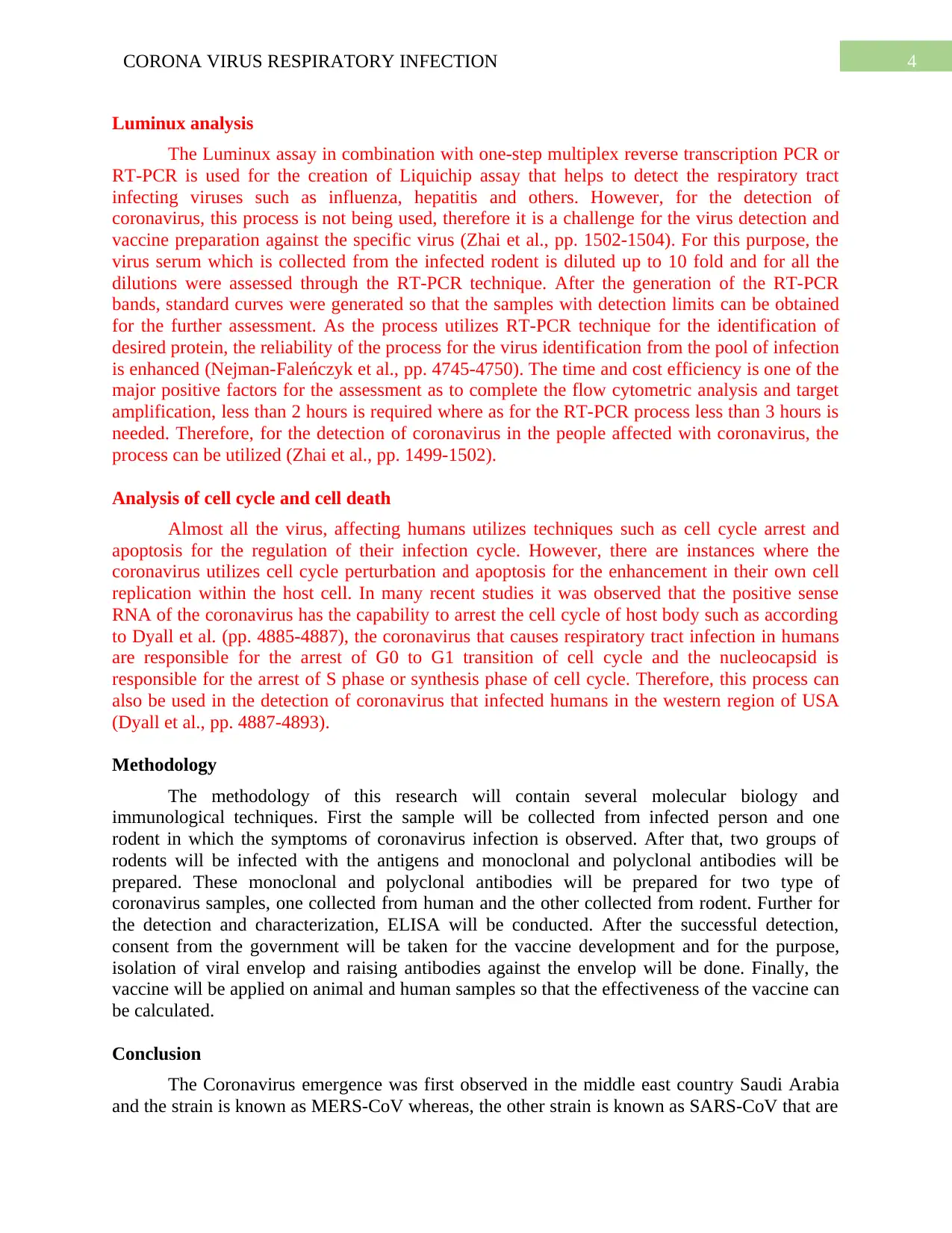
4CORONA VIRUS RESPIRATORY INFECTION
Luminux analysis
The Luminux assay in combination with one-step multiplex reverse transcription PCR or
RT-PCR is used for the creation of Liquichip assay that helps to detect the respiratory tract
infecting viruses such as influenza, hepatitis and others. However, for the detection of
coronavirus, this process is not being used, therefore it is a challenge for the virus detection and
vaccine preparation against the specific virus (Zhai et al., pp. 1502-1504). For this purpose, the
virus serum which is collected from the infected rodent is diluted up to 10 fold and for all the
dilutions were assessed through the RT-PCR technique. After the generation of the RT-PCR
bands, standard curves were generated so that the samples with detection limits can be obtained
for the further assessment. As the process utilizes RT-PCR technique for the identification of
desired protein, the reliability of the process for the virus identification from the pool of infection
is enhanced (Nejman-Faleńczyk et al., pp. 4745-4750). The time and cost efficiency is one of the
major positive factors for the assessment as to complete the flow cytometric analysis and target
amplification, less than 2 hours is required where as for the RT-PCR process less than 3 hours is
needed. Therefore, for the detection of coronavirus in the people affected with coronavirus, the
process can be utilized (Zhai et al., pp. 1499-1502).
Analysis of cell cycle and cell death
Almost all the virus, affecting humans utilizes techniques such as cell cycle arrest and
apoptosis for the regulation of their infection cycle. However, there are instances where the
coronavirus utilizes cell cycle perturbation and apoptosis for the enhancement in their own cell
replication within the host cell. In many recent studies it was observed that the positive sense
RNA of the coronavirus has the capability to arrest the cell cycle of host body such as according
to Dyall et al. (pp. 4885-4887), the coronavirus that causes respiratory tract infection in humans
are responsible for the arrest of G0 to G1 transition of cell cycle and the nucleocapsid is
responsible for the arrest of S phase or synthesis phase of cell cycle. Therefore, this process can
also be used in the detection of coronavirus that infected humans in the western region of USA
(Dyall et al., pp. 4887-4893).
Methodology
The methodology of this research will contain several molecular biology and
immunological techniques. First the sample will be collected from infected person and one
rodent in which the symptoms of coronavirus infection is observed. After that, two groups of
rodents will be infected with the antigens and monoclonal and polyclonal antibodies will be
prepared. These monoclonal and polyclonal antibodies will be prepared for two type of
coronavirus samples, one collected from human and the other collected from rodent. Further for
the detection and characterization, ELISA will be conducted. After the successful detection,
consent from the government will be taken for the vaccine development and for the purpose,
isolation of viral envelop and raising antibodies against the envelop will be done. Finally, the
vaccine will be applied on animal and human samples so that the effectiveness of the vaccine can
be calculated.
Conclusion
The Coronavirus emergence was first observed in the middle east country Saudi Arabia
and the strain is known as MERS-CoV whereas, the other strain is known as SARS-CoV that are
Luminux analysis
The Luminux assay in combination with one-step multiplex reverse transcription PCR or
RT-PCR is used for the creation of Liquichip assay that helps to detect the respiratory tract
infecting viruses such as influenza, hepatitis and others. However, for the detection of
coronavirus, this process is not being used, therefore it is a challenge for the virus detection and
vaccine preparation against the specific virus (Zhai et al., pp. 1502-1504). For this purpose, the
virus serum which is collected from the infected rodent is diluted up to 10 fold and for all the
dilutions were assessed through the RT-PCR technique. After the generation of the RT-PCR
bands, standard curves were generated so that the samples with detection limits can be obtained
for the further assessment. As the process utilizes RT-PCR technique for the identification of
desired protein, the reliability of the process for the virus identification from the pool of infection
is enhanced (Nejman-Faleńczyk et al., pp. 4745-4750). The time and cost efficiency is one of the
major positive factors for the assessment as to complete the flow cytometric analysis and target
amplification, less than 2 hours is required where as for the RT-PCR process less than 3 hours is
needed. Therefore, for the detection of coronavirus in the people affected with coronavirus, the
process can be utilized (Zhai et al., pp. 1499-1502).
Analysis of cell cycle and cell death
Almost all the virus, affecting humans utilizes techniques such as cell cycle arrest and
apoptosis for the regulation of their infection cycle. However, there are instances where the
coronavirus utilizes cell cycle perturbation and apoptosis for the enhancement in their own cell
replication within the host cell. In many recent studies it was observed that the positive sense
RNA of the coronavirus has the capability to arrest the cell cycle of host body such as according
to Dyall et al. (pp. 4885-4887), the coronavirus that causes respiratory tract infection in humans
are responsible for the arrest of G0 to G1 transition of cell cycle and the nucleocapsid is
responsible for the arrest of S phase or synthesis phase of cell cycle. Therefore, this process can
also be used in the detection of coronavirus that infected humans in the western region of USA
(Dyall et al., pp. 4887-4893).
Methodology
The methodology of this research will contain several molecular biology and
immunological techniques. First the sample will be collected from infected person and one
rodent in which the symptoms of coronavirus infection is observed. After that, two groups of
rodents will be infected with the antigens and monoclonal and polyclonal antibodies will be
prepared. These monoclonal and polyclonal antibodies will be prepared for two type of
coronavirus samples, one collected from human and the other collected from rodent. Further for
the detection and characterization, ELISA will be conducted. After the successful detection,
consent from the government will be taken for the vaccine development and for the purpose,
isolation of viral envelop and raising antibodies against the envelop will be done. Finally, the
vaccine will be applied on animal and human samples so that the effectiveness of the vaccine can
be calculated.
Conclusion
The Coronavirus emergence was first observed in the middle east country Saudi Arabia
and the strain is known as MERS-CoV whereas, the other strain is known as SARS-CoV that are

5CORONA VIRUS RESPIRATORY INFECTION
found to be effecting populations in western region of USA. Therefore, the assignment was
determined to characterize the coronavirus infection the population and for that purpose, it
utilizes the generation of monoclonal and polyclonal antibodies against the specific viral
antigens. Further, using this process, the specific viral structural component that is the outer
envelope was determined for the vaccine preparation. This research proposal also conducted
literature review to critically determine the usage of viral envelop for the vaccine preparation.
Finally the methodological flow of the research has also been presented.
found to be effecting populations in western region of USA. Therefore, the assignment was
determined to characterize the coronavirus infection the population and for that purpose, it
utilizes the generation of monoclonal and polyclonal antibodies against the specific viral
antigens. Further, using this process, the specific viral structural component that is the outer
envelope was determined for the vaccine preparation. This research proposal also conducted
literature review to critically determine the usage of viral envelop for the vaccine preparation.
Finally the methodological flow of the research has also been presented.
⊘ This is a preview!⊘
Do you want full access?
Subscribe today to unlock all pages.

Trusted by 1+ million students worldwide
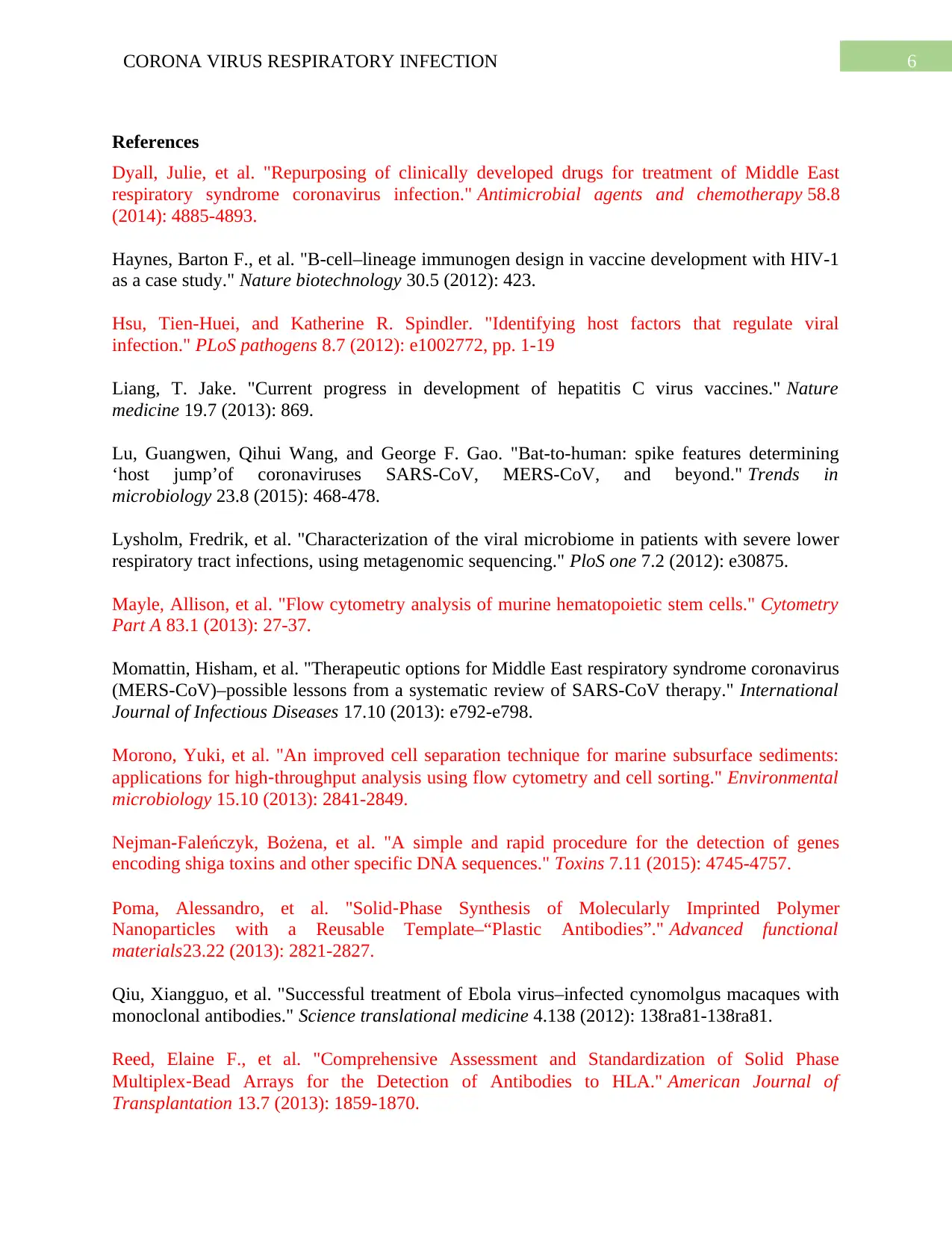
6CORONA VIRUS RESPIRATORY INFECTION
References
Dyall, Julie, et al. "Repurposing of clinically developed drugs for treatment of Middle East
respiratory syndrome coronavirus infection." Antimicrobial agents and chemotherapy 58.8
(2014): 4885-4893.
Haynes, Barton F., et al. "B-cell–lineage immunogen design in vaccine development with HIV-1
as a case study." Nature biotechnology 30.5 (2012): 423.
Hsu, Tien-Huei, and Katherine R. Spindler. "Identifying host factors that regulate viral
infection." PLoS pathogens 8.7 (2012): e1002772, pp. 1-19
Liang, T. Jake. "Current progress in development of hepatitis C virus vaccines." Nature
medicine 19.7 (2013): 869.
Lu, Guangwen, Qihui Wang, and George F. Gao. "Bat-to-human: spike features determining
‘host jump’of coronaviruses SARS-CoV, MERS-CoV, and beyond." Trends in
microbiology 23.8 (2015): 468-478.
Lysholm, Fredrik, et al. "Characterization of the viral microbiome in patients with severe lower
respiratory tract infections, using metagenomic sequencing." PloS one 7.2 (2012): e30875.
Mayle, Allison, et al. "Flow cytometry analysis of murine hematopoietic stem cells." Cytometry
Part A 83.1 (2013): 27-37.
Momattin, Hisham, et al. "Therapeutic options for Middle East respiratory syndrome coronavirus
(MERS-CoV)–possible lessons from a systematic review of SARS-CoV therapy." International
Journal of Infectious Diseases 17.10 (2013): e792-e798.
Morono, Yuki, et al. "An improved cell separation technique for marine subsurface sediments:
applications for high‐throughput analysis using flow cytometry and cell sorting." Environmental
microbiology 15.10 (2013): 2841-2849.
Nejman-Faleńczyk, Bożena, et al. "A simple and rapid procedure for the detection of genes
encoding shiga toxins and other specific DNA sequences." Toxins 7.11 (2015): 4745-4757.
Poma, Alessandro, et al. "Solid‐Phase Synthesis of Molecularly Imprinted Polymer
Nanoparticles with a Reusable Template–“Plastic Antibodies”." Advanced functional
materials23.22 (2013): 2821-2827.
Qiu, Xiangguo, et al. "Successful treatment of Ebola virus–infected cynomolgus macaques with
monoclonal antibodies." Science translational medicine 4.138 (2012): 138ra81-138ra81.
Reed, Elaine F., et al. "Comprehensive Assessment and Standardization of Solid Phase
Multiplex‐Bead Arrays for the Detection of Antibodies to HLA." American Journal of
Transplantation 13.7 (2013): 1859-1870.
References
Dyall, Julie, et al. "Repurposing of clinically developed drugs for treatment of Middle East
respiratory syndrome coronavirus infection." Antimicrobial agents and chemotherapy 58.8
(2014): 4885-4893.
Haynes, Barton F., et al. "B-cell–lineage immunogen design in vaccine development with HIV-1
as a case study." Nature biotechnology 30.5 (2012): 423.
Hsu, Tien-Huei, and Katherine R. Spindler. "Identifying host factors that regulate viral
infection." PLoS pathogens 8.7 (2012): e1002772, pp. 1-19
Liang, T. Jake. "Current progress in development of hepatitis C virus vaccines." Nature
medicine 19.7 (2013): 869.
Lu, Guangwen, Qihui Wang, and George F. Gao. "Bat-to-human: spike features determining
‘host jump’of coronaviruses SARS-CoV, MERS-CoV, and beyond." Trends in
microbiology 23.8 (2015): 468-478.
Lysholm, Fredrik, et al. "Characterization of the viral microbiome in patients with severe lower
respiratory tract infections, using metagenomic sequencing." PloS one 7.2 (2012): e30875.
Mayle, Allison, et al. "Flow cytometry analysis of murine hematopoietic stem cells." Cytometry
Part A 83.1 (2013): 27-37.
Momattin, Hisham, et al. "Therapeutic options for Middle East respiratory syndrome coronavirus
(MERS-CoV)–possible lessons from a systematic review of SARS-CoV therapy." International
Journal of Infectious Diseases 17.10 (2013): e792-e798.
Morono, Yuki, et al. "An improved cell separation technique for marine subsurface sediments:
applications for high‐throughput analysis using flow cytometry and cell sorting." Environmental
microbiology 15.10 (2013): 2841-2849.
Nejman-Faleńczyk, Bożena, et al. "A simple and rapid procedure for the detection of genes
encoding shiga toxins and other specific DNA sequences." Toxins 7.11 (2015): 4745-4757.
Poma, Alessandro, et al. "Solid‐Phase Synthesis of Molecularly Imprinted Polymer
Nanoparticles with a Reusable Template–“Plastic Antibodies”." Advanced functional
materials23.22 (2013): 2821-2827.
Qiu, Xiangguo, et al. "Successful treatment of Ebola virus–infected cynomolgus macaques with
monoclonal antibodies." Science translational medicine 4.138 (2012): 138ra81-138ra81.
Reed, Elaine F., et al. "Comprehensive Assessment and Standardization of Solid Phase
Multiplex‐Bead Arrays for the Detection of Antibodies to HLA." American Journal of
Transplantation 13.7 (2013): 1859-1870.
Paraphrase This Document
Need a fresh take? Get an instant paraphrase of this document with our AI Paraphraser
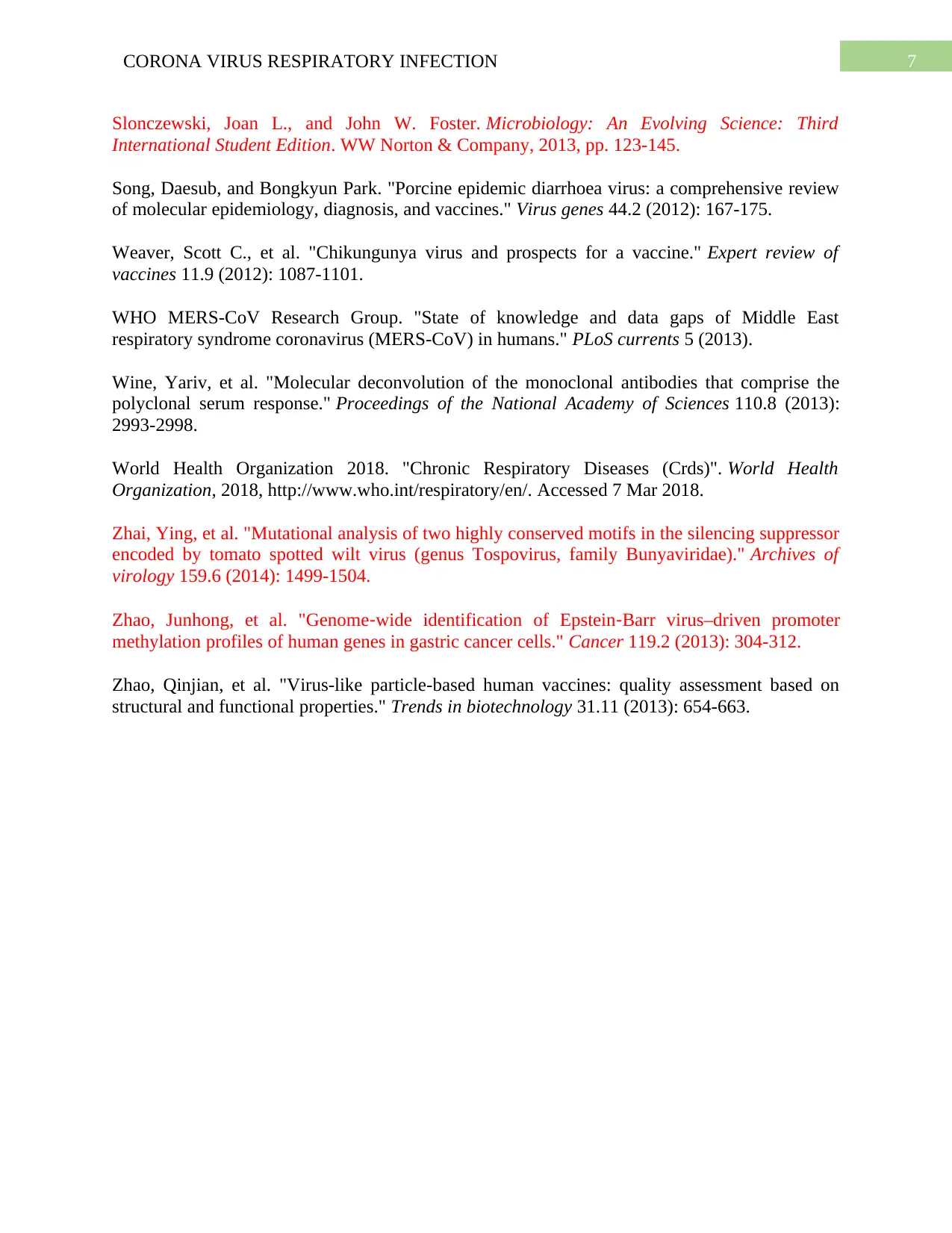
7CORONA VIRUS RESPIRATORY INFECTION
Slonczewski, Joan L., and John W. Foster. Microbiology: An Evolving Science: Third
International Student Edition. WW Norton & Company, 2013, pp. 123-145.
Song, Daesub, and Bongkyun Park. "Porcine epidemic diarrhoea virus: a comprehensive review
of molecular epidemiology, diagnosis, and vaccines." Virus genes 44.2 (2012): 167-175.
Weaver, Scott C., et al. "Chikungunya virus and prospects for a vaccine." Expert review of
vaccines 11.9 (2012): 1087-1101.
WHO MERS-CoV Research Group. "State of knowledge and data gaps of Middle East
respiratory syndrome coronavirus (MERS-CoV) in humans." PLoS currents 5 (2013).
Wine, Yariv, et al. "Molecular deconvolution of the monoclonal antibodies that comprise the
polyclonal serum response." Proceedings of the National Academy of Sciences 110.8 (2013):
2993-2998.
World Health Organization 2018. "Chronic Respiratory Diseases (Crds)". World Health
Organization, 2018, http://www.who.int/respiratory/en/. Accessed 7 Mar 2018.
Zhai, Ying, et al. "Mutational analysis of two highly conserved motifs in the silencing suppressor
encoded by tomato spotted wilt virus (genus Tospovirus, family Bunyaviridae)." Archives of
virology 159.6 (2014): 1499-1504.
Zhao, Junhong, et al. "Genome‐wide identification of Epstein‐Barr virus–driven promoter
methylation profiles of human genes in gastric cancer cells." Cancer 119.2 (2013): 304-312.
Zhao, Qinjian, et al. "Virus-like particle-based human vaccines: quality assessment based on
structural and functional properties." Trends in biotechnology 31.11 (2013): 654-663.
Slonczewski, Joan L., and John W. Foster. Microbiology: An Evolving Science: Third
International Student Edition. WW Norton & Company, 2013, pp. 123-145.
Song, Daesub, and Bongkyun Park. "Porcine epidemic diarrhoea virus: a comprehensive review
of molecular epidemiology, diagnosis, and vaccines." Virus genes 44.2 (2012): 167-175.
Weaver, Scott C., et al. "Chikungunya virus and prospects for a vaccine." Expert review of
vaccines 11.9 (2012): 1087-1101.
WHO MERS-CoV Research Group. "State of knowledge and data gaps of Middle East
respiratory syndrome coronavirus (MERS-CoV) in humans." PLoS currents 5 (2013).
Wine, Yariv, et al. "Molecular deconvolution of the monoclonal antibodies that comprise the
polyclonal serum response." Proceedings of the National Academy of Sciences 110.8 (2013):
2993-2998.
World Health Organization 2018. "Chronic Respiratory Diseases (Crds)". World Health
Organization, 2018, http://www.who.int/respiratory/en/. Accessed 7 Mar 2018.
Zhai, Ying, et al. "Mutational analysis of two highly conserved motifs in the silencing suppressor
encoded by tomato spotted wilt virus (genus Tospovirus, family Bunyaviridae)." Archives of
virology 159.6 (2014): 1499-1504.
Zhao, Junhong, et al. "Genome‐wide identification of Epstein‐Barr virus–driven promoter
methylation profiles of human genes in gastric cancer cells." Cancer 119.2 (2013): 304-312.
Zhao, Qinjian, et al. "Virus-like particle-based human vaccines: quality assessment based on
structural and functional properties." Trends in biotechnology 31.11 (2013): 654-663.
1 out of 8
Your All-in-One AI-Powered Toolkit for Academic Success.
+13062052269
info@desklib.com
Available 24*7 on WhatsApp / Email
![[object Object]](/_next/static/media/star-bottom.7253800d.svg)
Unlock your academic potential
Copyright © 2020–2025 A2Z Services. All Rights Reserved. Developed and managed by ZUCOL.


